Jupiter’s North Pole Unlike Anything Encountered In Solar System
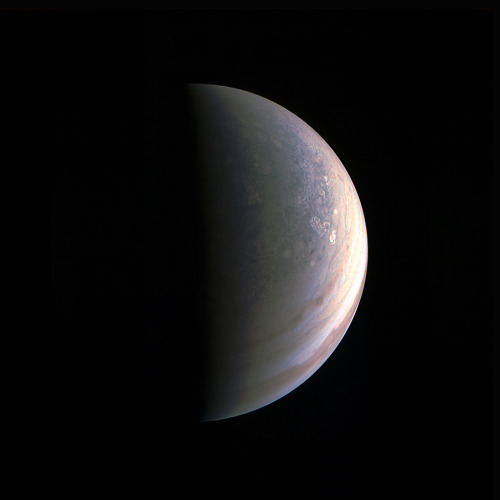
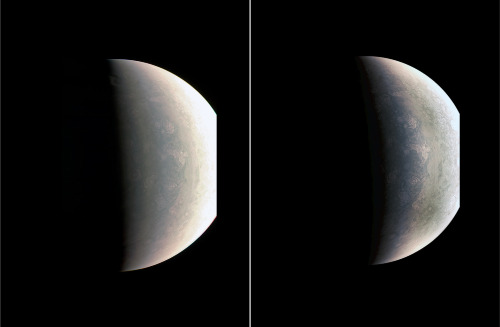
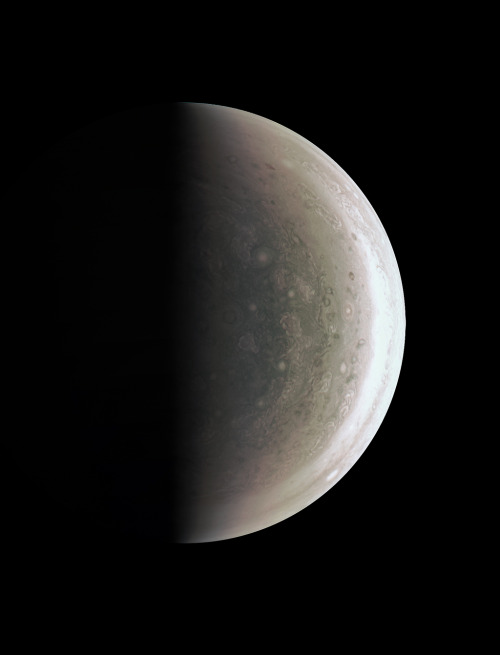
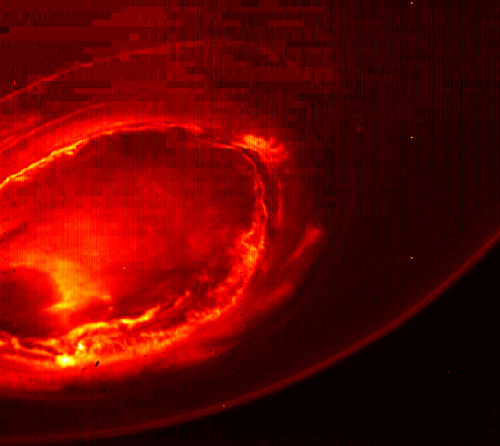
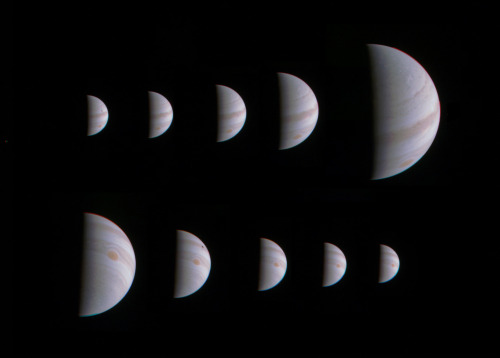
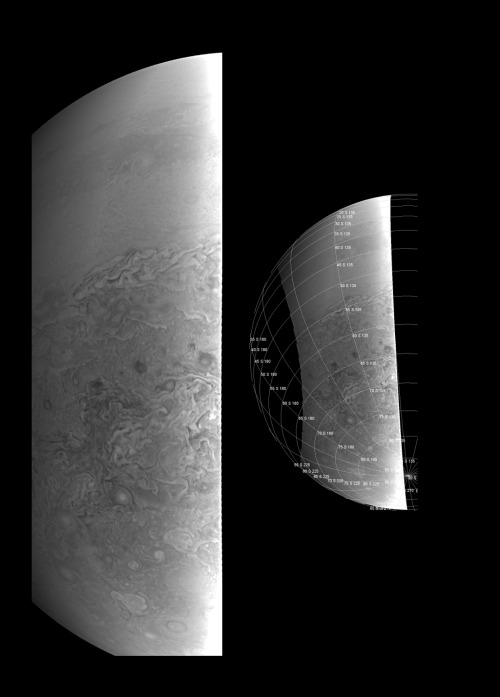
Jupiter’s North Pole Unlike Anything Encountered in Solar System
NASA’s Juno spacecraft has sent back the first-ever images of Jupiter’s north pole, taken during the spacecraft’s first flyby of the planet with its instruments switched on. The images show storm systems and weather activity unlike anything previously seen on any of our solar system’s gas-giant planets.
Juno successfully executed the first of 36 orbital flybys on Aug. 27 when the spacecraft came about 2,500 miles (4,200 kilometers) above Jupiter’s swirling clouds. The download of six megabytes of data collected during the six-hour transit, from above Jupiter’s north pole to below its south pole, took one-and-a-half days. While analysis of this first data collection is ongoing, some unique discoveries have already made themselves visible.
“First glimpse of Jupiter’s north pole, and it looks like nothing we have seen or imagined before,” said Scott Bolton, principal investigator of Juno from the Southwest Research Institute in San Antonio. “It’s bluer in color up there than other parts of the planet, and there are a lot of storms. There is no sign of the latitudinal bands or zone and belts that we are used to – this image is hardly recognizable as Jupiter. We’re seeing signs that the clouds have shadows, possibly indicating that the clouds are at a higher altitude than other features.”
One of the most notable findings of these first-ever pictures of Jupiter’s north and south poles is something that the JunoCam imager did not see.
“Saturn has a hexagon at the north pole,” said Bolton. “There is nothing on Jupiter that anywhere near resembles that. The largest planet in our solar system is truly unique. We have 36 more flybys to study just how unique it really is.”
Along with JunoCam snapping pictures during the flyby, all eight of Juno’s science instruments were energized and collecting data. The Jovian Infrared Auroral Mapper (JI-RAM), supplied by the Italian Space Agency, acquired some remarkable images of Jupiter at its north and south polar regions in infrared wavelengths.
“JIRAM is getting under Jupiter’s skin, giving us our first infrared close-ups of the planet,” said Alberto Adriani, JIRAM co-investigator from Istituto di Astrofisica e Planetologia Spaziali, Rome. “These first infrared views of Jupiter’s north and south poles are revealing warm and hot spots that have never been seen before. And while we knew that the first ever infrared views of Jupiter’s south pole could reveal the planet’s southern aurora, we were amazed to see it for the first time. No other instruments, both from Earth or space, have been able to see the southern aurora. Now, with JIRAM, we see that it appears to be very bright and well structured. The high level of detail in the images will tell us more about the aurora’s morphology and dynamics.”
Among the more unique data sets collected by Juno during its first scientific sweep by Jupiter was that acquired by the mission’s Radio/Plasma Wave Experiment (Waves), which recorded ghostly- sounding transmissions emanating from above the planet. These radio emissions from Jupiter have been known about since the 1950s but had never been analyzed from such a close vantage point.
“Jupiter is talking to us in a way only gas-giant worlds can,” said Bill Kurth, co-investigator for the Waves instrument from the University of Iowa, Iowa City. “Waves detected the signature emissions of the energetic particles that generate the massive auroras which encircle Jupiter’s north pole. These emissions are the strongest in the solar system. Now we are going to try to figure out where the electrons come from that are generating them.”
The Juno spacecraft launched on Aug. 5, 2011, from Cape Canaveral, Florida and arrived at Jupiter on July 4, 2016. JPL manages the Juno mission for the principal investigator, Scott Bolton, of Southwest Research Institute in San Antonio. Juno is part of NASA’s New Frontiers Program, which is managed at NASA’s Marshall Space Flight Center in Huntsville, Alabama, for NASA’s Science Mission Directorate. Lockheed Martin Space Systems, Denver, built the spacecraft. Caltech in Pasadena, California, manages JPL for NASA.
IMAGE 1….As NASA’s Juno spacecraft closed in on Jupiter for its Aug. 27, 2016 pass, its view grew sharper and fine details in the north polar region became increasingly visible. The JunoCam instrument obtained this view on August 27, about two hours before closest approach, when the spacecraft was 120,000 miles (195,000 kilometers) away from the giant planet (i.e., for Jupiter’s center). Unlike the equatorial region’s familiar structure of belts and zones, the poles are mottled with rotating storms of various sizes, similar to giant versions of terrestrial hurricanes. Jupiter’s poles have not been seen from this perspective since the Pioneer 11 spacecraft flew by the planet in 1974.
IMAGE 2….Storm systems and weather activity unlike anything encountered in the solar system are on view in these color images of Jupiter’s north polar region from NASA’s Juno spacecraft. Two versions of the image have been contrast-enhanced differently to bring out detail near the dark terminator and near the bright limb. The JunoCam instrument took the images to create this color view on August 27, when the spacecraft was about 48,000 miles (78,000 kilometers) above the polar cloud tops. A wavy boundary is visible halfway between the grayish region at left (closer to the pole and the nightside shadow) and the lighter-colored area on the right. The wavy appearance of the boundary represents a Rossby wave – a north-south meandering of a predominantly east-west flow in an atmospheric jet. This may be caused by a difference in temperature between air to the north and south of this boundary, as is often the case with such waves in Earth’s atmosphere. The polar region is filled with a variety of discrete atmospheric features. Some of these are ovals, but the larger and brighter features have a “pinwheel” shape reminiscent of the shape of terrestrial hurricanes. Tracking the motion and evolution of these features across multiple orbits will provide clues about the dynamics of the Jovian atmosphere. This image also provides the first example of cloud shadowing on Jupiter: near the top of the image, a high cloud feature is seen past the normal boundary between day and night, illuminated above the cloud deck below. While subtle color differences are visible in the image, some of these are likely the result of scattered light within the JunoCam optics. Work is ongoing to characterize these effects.
IMAGE 3….This image from NASA’s Juno spacecraft provides a never-before-seen perspective on Jupiter’s south pole. The JunoCam instrument acquired the view on August 27, 2016, when the spacecraft was about 58,700 miles (94,500 kilometers) above the polar region. At this point, the spacecraft was about an hour past its closest approach, and fine detail in the south polar region is clearly resolved. Unlike the equatorial region’s familiar structure of belts and zones, the poles are mottled by clockwise and counterclockwise rotating storms of various sizes, similar to giant versions of terrestrial hurricanes. The south pole has never been seen from this viewpoint, although the Cassini spacecraft was able to observe most of the polar region at highly oblique angles as it flew past Jupiter on its way to Saturn in 2000
IMAGE 4….This infrared image gives an unprecedented view of the southern aurora of Jupiter, as captured by NASA’s Juno spacecraft on August 27, 2016. The planet’s southern aurora can hardly be seen from Earth due to our home planet’s position in respect to Jupiter’s south pole. Juno’s unique polar orbit provides the first opportunity to observe this region of the gas-giant planet in detail. Juno’s Jovian Infrared Auroral Mapper (JIRAM) camera acquired the view at wavelengths ranging from 3.3 to 3.6 microns – the wavelengths of light emitted by excited hydrogen ions in the polar regions. The view is a mosaic of three images taken just minutes apart from each other, about four hours after the perijove pass while the spacecraft was moving away from Jupiter.
IMAGE 5….This montage of 10 JunoCam images shows Jupiter growing and shrinking in apparent size before and after NASA’s Juno spacecraft made its closest approach on August 27, 2016, at 12:50 UTC. The images are spaced about 10 hours apart, one Jupiter day, so the Great Red Spot is always in roughly the same place. The small black spots visible on the planet in some of the images are shadows of the large Galilean moons. The images in the top row were taken during the inbound leg of the orbit, beginning on August 25 at 13:15 UTC when Juno was 1.4 million miles (2.3 million kilometers) away from Jupiter, and continuing to August 27 at 04:45 UTC when the spacecraft was 430,000 miles (700,000 kilometers) away. The images in the bottom row were obtained during the outbound leg of the orbit. They begin on August 28 at 00:45 UTC when Juno was 750,000 miles (920,000 kilometers) away and continue to August 29 at 16:45 UTC when the spacecraft was 1.6 million miles (2.5 million kilometers) away.
IMAGE 6….This image provides a close-up view of Jupiter’s southern hemisphere, as seen by NASA’s Juno spacecraft on August 27, 2016. The JunoCam instrument captured this image with its red spectral filter when the spacecraft was about 23,600 miles (38,000 kilometers) above the cloud tops. The image covers an area from close to the south pole to 20 degrees south of the equator, centered on a longitude at about 140 degrees west. The transition between the banded structures near the equator and the more chaotic polar region (south of about 65 degrees south latitude) can be clearly seen. The smaller version at right of this image shows the same view with a latitude/longitude grid overlaid. This image has been processed to remove shading effects near the terminator – the dividing line between day and night – caused by Juno’s orbit.
More Posts from Curiositytherover and Others

Physicists in Germany have built the most accurate timepiece on Earth, achieving unprecedented levels of accuracy with a new atomic clock that keeps time according to the movements of ytterbium ions.
Called an optical single-ion clock, the device works by measuring the vibrational frequency of ytterbium ions as they oscillate back and forth hundreds of trillions times per second between two different energy levels. These ions are trapped within an ‘optical lattice’ of laser beams that allows scientists to count the number of ytterbium 'ticks’ per second to measure time so accurately, the clock won’t lose or gain a second in several billion years.
Until very recently, our most accurate time-keepers were caesium atomic clocks - devices that contain a 'pendulum’ of atoms that are excited into resonance by microwave radiation. It’s on these clocks that the official definition of the second - the Standard International (SI) unit of time - is based.

One thing we’re always doing as a species is expanding our knowledge of the heavens. We send out probes, robots, satellites, spacecraft, all to map out and add to our ever-expanding picture of what the Universe looks like.
But what if that picture suddenly became smaller? That is exactly what happened when new data from the Planck satellite tightened our previous notions of the observable universe, shrinking its area by 0.7%.
If you’ve never realized, we don’t actually see all of the stars in the Universe. If we did, night time sky would be a whole lot brighter. Instead, we see everything within a particular radius, the particle horizon. Any particle of light emitted outside that particle horizon is too far to have reached us.
So if we want to know just how large the observable universe is, we just have to figure out the distance between us and that particle horizon, right?
As it turns out, not quite.
The universe, specifically spacetime, is continuously expanding, with points in the universe moving further apart. This not only changes the distance between objects but also how fast light is moving in the universe.
The movement of spacetime has an effect on which photons reach us and can be observed.
So how do you calculate the radius? Back in 2003, scientists came up with an equation that took an event called “the recombination” as a reference point in the universe’s history. They combined that with the rate of the expansion of the universe and several other factors, in the end coming up with a number.
Back in 2003, that number was a radius of 45.66 billion light-years. Now, new data revealed a far more accurate number: 45.34 billion light-years.
“A difference of 320 million light-years might be peanuts on the cosmic scale, but it does make our knowable universe a little bit cozier,” Nick Tomasello from the University of the Sciences in Philadelphia writes over at Medium.
The study has been accepted for publication in an upcoming edition of Advances in Astrophysics.


Rosette Nebula
Stardust

The US space agency has just announced that it’ll be sticking four volunteers inside a tiny house for 30 days, as part of an experiment to test how isolation and “close quarters” affect people’s behaviour. Once inside, the volunteers can’t leave the cabin, and will only be able to regularly communicate with each other and NASA mission control (that means no Internet).
It sounds pretty uncomfortable, but if we want to make it further into space - all the way to Mars, for example - people are going to have to live in cramped spaces for months at a time with very little contact with the outside world, and scientists need to be able to predict the effects - including every little thing that could go wrong.
The compact, three-storey house that the volunteers will be living in is called the Human Research Exploration Analog (HERA), and it’s what NASA is calling a “science-making house”. That means there are lots of little experiments on board to keep the team occupied, like plants to grow and tiny shrimp to take care of.

Scientists Find Two Natural Genes in our Cells That Can Combat HIV
During the opening era of the AIDS epidemic, being diagnosed was a death sentence. Thanks to advances in medicine, it isn’t anymore. HIV is no longer a terminal illness; with treatment, an individual with HIV has the exact same life expectancy as someone without the disease.
However, it is still a devastating virus. The treatments have many side effects, and you will need to take the medicine for the rest of your life.
For years, scientists have been trying to find a way to effectively cure HIV/AIDS, but unfortunately, none yet have made that incredible leap. But new breakthroughs come each year, which slowly bring us closer to our goal.
Case in point, last month, researchers from the University of Massachusetts Medical School announced the discovery of proteins that naturally inhibit the human immunodeficiency virus. Surprisingly, they found these proteins in the cells in our immune system’s T cells, which are the cells that HIV attacks (specifically, it attacks CD4 positive T cells, which are white blood cells that are vital to fighting off infection).
Find out more at: http://futurism.com/links/scientists-find-two-natural-genes-in-our-cells-that-can-combat-hiv/

The strange tale of the Snowflake Man
Wilson Bentley caused a flurry with his pioneering pictures of individual snowflakes, and his results are astonishing – so why was he seen as an oddball outsider?



What would Earth’s skies look like with Saturn’s rings?
Illustrator and author Ron Miller specializes in, among other things, incredible visualizations of other worlds. Now, Miller brings his visualizations back to Earth for a series exploring what our skies would look like with Saturn’s majestic rings. Miller strived to make the images scientifically accurate, adding nice touches like orange-pink shadows resulting from sunlight passing through the Earth’s atmosphere. He also shows the rings from a variety of latitudes and landscapes, from the U.S. Capitol building to Mayan ruins in Guatemala.
Images and text via

Can we just take a moment to appreciate how incredible our Solar System is? Sure, pretty much everywhere other than our own planet is a deathtrap, with acid rain pouring down on Venus and storms three times the size of Earth swirling around Jupiter, but you don’t have to look too hard to find the unique beauty in our neighbouring planets and moons.
And with unique beauty comes… tourism! From the diamond-inspired cloud observatory of Venus to Jupiter’s aurorae-backed balloon ride, the design team from NASA’s Jet Propulsion Laboratory (JPL) have taken us back to the future with this new batch of retro space tourism posters.
The “Visions of the Future” series features seven original posters released this week, plus seven “Exoplanet Travel Bureau” posters that were published around this time last year. And these haven’t just been dreamt up by anyone - the designers behind the posters have been consulting with JPL scientists and engineers to come up with tourism scenarios that are as realistic as they are fantastical.

Before US astronaut Scott Kelly returned from his year-long mission aboard the International Space Station, he shared photos of his very last sunrise in space.
I think you need to see the full photos, in all their glory:












Source
-
 deadassdiaspore reblogged this · 4 years ago
deadassdiaspore reblogged this · 4 years ago -
 sonicsoundscapes liked this · 6 years ago
sonicsoundscapes liked this · 6 years ago -
 a-splash-of-indigo liked this · 6 years ago
a-splash-of-indigo liked this · 6 years ago -
 king-sir-44 reblogged this · 7 years ago
king-sir-44 reblogged this · 7 years ago -
 king-sir-44 liked this · 7 years ago
king-sir-44 liked this · 7 years ago -
 oruamatrop-blog liked this · 8 years ago
oruamatrop-blog liked this · 8 years ago -
 palaxies reblogged this · 8 years ago
palaxies reblogged this · 8 years ago -
 brunorichardsonmachado-blog liked this · 8 years ago
brunorichardsonmachado-blog liked this · 8 years ago -
 coldcemeteries liked this · 8 years ago
coldcemeteries liked this · 8 years ago -
 fomaelhaut reblogged this · 8 years ago
fomaelhaut reblogged this · 8 years ago -
 tthomusic liked this · 8 years ago
tthomusic liked this · 8 years ago -
 petros2020-blog liked this · 8 years ago
petros2020-blog liked this · 8 years ago -
 completely-overjoyed-blog1 liked this · 8 years ago
completely-overjoyed-blog1 liked this · 8 years ago -
 lauregui-mcgrath liked this · 8 years ago
lauregui-mcgrath liked this · 8 years ago -
 lady--nebula reblogged this · 8 years ago
lady--nebula reblogged this · 8 years ago -
 happy-thoughts--and--pixie-dust liked this · 8 years ago
happy-thoughts--and--pixie-dust liked this · 8 years ago -
 midna2123 reblogged this · 8 years ago
midna2123 reblogged this · 8 years ago -
 midna2123 liked this · 8 years ago
midna2123 liked this · 8 years ago -
 depress-ed-bitxh liked this · 8 years ago
depress-ed-bitxh liked this · 8 years ago -
 dpeman liked this · 8 years ago
dpeman liked this · 8 years ago -
 aesthetically-pleasing-worldx liked this · 8 years ago
aesthetically-pleasing-worldx liked this · 8 years ago -
 alostandlonelygirl liked this · 8 years ago
alostandlonelygirl liked this · 8 years ago -
 heyitsdelaila liked this · 8 years ago
heyitsdelaila liked this · 8 years ago -
 ramon-balaguer liked this · 8 years ago
ramon-balaguer liked this · 8 years ago -
 stew31415 liked this · 8 years ago
stew31415 liked this · 8 years ago -
 netflixandchillforone liked this · 8 years ago
netflixandchillforone liked this · 8 years ago -
 bugzymrmalone-blog liked this · 8 years ago
bugzymrmalone-blog liked this · 8 years ago -
 duranwang liked this · 8 years ago
duranwang liked this · 8 years ago -
 nightvalescommunityobelisk liked this · 8 years ago
nightvalescommunityobelisk liked this · 8 years ago -
 ptvtonyp liked this · 8 years ago
ptvtonyp liked this · 8 years ago -
 girlsoverdxse-blog liked this · 8 years ago
girlsoverdxse-blog liked this · 8 years ago -
 somethinglite liked this · 8 years ago
somethinglite liked this · 8 years ago -
 meritbridal-blog liked this · 8 years ago
meritbridal-blog liked this · 8 years ago -
 thatchloe liked this · 8 years ago
thatchloe liked this · 8 years ago -
 photographyblog11 liked this · 8 years ago
photographyblog11 liked this · 8 years ago